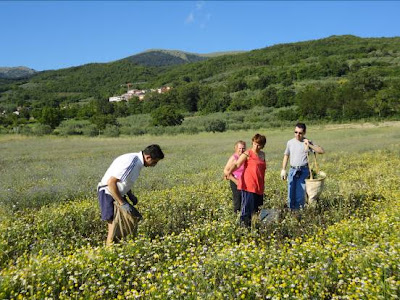I was invited to join one of the groups participating and I hope to capture and convey the very special moments leading up to and during the construction of our carpet.
This practice is recorded in the 17th century as part of Baroque festivals in Rome. Its origins are believed to result from experimentation by the florists of the Vatican using crushed flowers to recreate the mosaic artworks contained within. However in Spello, it seems to have developed a little more poignantly.
A woman of the village decorated the entrance to her house with a small, simple floral carpet to welcome the passage of the religious procession of Corpus Domini. The flowers were picked from the fields surrounding the town. The other townsfolk appreciated this gesture and it became a competitive practice. This ethos remains today and brings an infectious communal energy, magnificent floral works and many visitors to Spello.
It began for me one warm afternoon. We met in a piazzetta where we were issued with a well-worn, custom made shoulder bag and some buckets. In small, aged cars we wound our way up ever diminishing roads to indescribable scenic beauty and fields of daisies. The chatter was constant, in Italian of course, smattered with laughter and obvious warm camaraderie. In the four weeks or so of almost daily excursions, my language skills took on an osmotic nature.
The leader of the ‘group’ was a young solicitor, Paolo, a passionate Spellano, who cajoled his team to brave the heat and distances to collect the vast amounts of material in all the colours needed for his design.
His team consisted of an itinerant trio of ‘stranieri’ (foreigners - in their late 50’s) and a dedicated local group of all ages with years of experience.
How did he know where to go for the blue cornflowers or the white daisies or the yellow broom? Years of secrets were held fast so other teams did not poach ideas or precious flowers! This clandestine tone built an air of excitement as the weeks passed.
If we were not picking flowers we joined a hardy group in the piazzetta to ‘process’ the flowers…removing petals, drying some in the oven...sorting them in boxes and putting them in a home-made rack especially for dry storage. Lots more chatter and camaraderie!
One hot afternoon I was invited to the kitchen of Giuliana. She taught me to make pasta…with freshly ground flour and eggs so fresh they were still warm! The special board was well worn from the biweekly ritual. We cut ‘tagliatelle, tagliatini’ and various nameless shapes for soup. Of course, it was the best pasta I have ever tasted!
As I was returning to my apartment, the various ‘cantine’ along the way were filled with similar groups preparing their flowers. Wafting down along the alleys the smell of simmering ‘pomodoro, pasta and pancetta’ filled the air. People were spilling out onto the streets, strolling and chatting… taking their ‘passegiatta’- the evening social practice all over Italy. A friendly ‘buona sera’ was received all along my route home. ‘Favoloso!’
The big day arrived...a beautiful balmy day. A group of twelve assembled early and drove into the mountains to do the last picking of the blue cornflowers… we needed the fresh blue for intensity of colour. The air of excitement was palpable. We had a sumptuous morning tea of ‘mortadella e pane’ and various ‘dolci’ sitting amongst the flowers.
On return, Spello was closed to traffic. The village streets and ‘piazzas’ became strewn with small and large temporary shelters with boxes of multiple coloured flower petals gathered beneath. Large stencils carefully labelled and coded were stuck to the pavements in readiness.
Our allotted area was in a long, narrow thoroughfare and the evening breeze was proving to be a problem…flower petals blowing away was not desirable! The ‘White Night’ had begun, so called because the town does not sleep. Shops stay open and activity is intense! It is truly a long, fascinating night.
Our design was commenced at 1 am. A group of about six people began placing the various colours as the stencil indicated. We all had a turn …some with sturdier knees lasted all night!
There were calls for more fresh green material for the borders…this created a flurry in the ‘cantina’ where we sat with chopping boards on our knees and chopped up wild fennel very finely. The smell was intoxicating! Visitors and friends filed past and chatted, offered advice and joined in for short shifts of activity! All quietly and stress free the carpet grew…only Paolo worried about the deadline of 9 am for the judging.
Coffee flowed as the night progressed and wonderful ‘pizzas’ cooked by the same hard workers were passed around.
As the sun rose, a scene of wonderment unfolded as I strolled around the village. Shelters were being dismantled and many weary people were frantically adding the finishing touches. It was hard to believe so many perfect, intricate and colourful creations had been constructed in just twelve hours. Tiredness was evident but pride filled the air. Crowds of onlookers peered over and under for the best view. Cameras clicked incessantly!
The air filled with the sounds of brass and percussion music ...the procession of sumptuous pageantry approached. The bishop and his entourage processed over the floral carpets as the climax to the Corpus Domini celebrations.
In the evening, after sleeping a few precious hours, we met in the ‘piazza’. The results were announced….it seemed almost everyone had won a prize! This was followed by a celebratory dinner at a local ‘Trattoria’. A typical Umbrian feast of ‘antipasto, pasta and dolci’ was ‘buonissimo’!.
As we walked home, the street sweepers had almost disposed of all the petals and other debris…...so much work for just a few hours but such a glorious experience!











